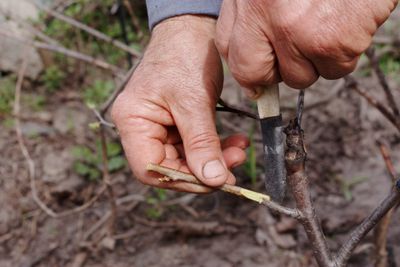However, once you start reading up on growing fruit trees, you’ll discover many fruit trees planted by seed can take three to eight years to start producing fruit. In eight years, the kids may be off to college or starting families of their own. For this reason, many gardeners choose to purchase immediately fruiting trees that are grafted on already established rootstock. What is rootstock? Continue reading to learn about rootstock plants.
Rootstock Information
Rootstock is the base and root portion of grafted plants. A scion, the flowering and/or fruiting part of the plant, is grafted onto rootstock for a variety of reasons. The scion and rootstock must be of closely related plant species in order for the graft to work. For example, in fruit trees, pitted fruit like cherry and plum can be rootstock and scion for each other, but an apple tree cannot be used as rootstock for a plum scion and vice versa. Rootstock plants are selected not only for their close relation to the desired plant, but also for the attributes it will give to the desired plant. In the world of grafting, there are many more scion varieties available than rootstock varieties. Rootstock varieties may come from naturally growing trees, unique naturally occurring plant mutations, or be genetically bred for the purpose of being rootstock. When a successful rootstock plant is identified, it is then propagated asexually to create exact clones of it for use as future rootstock.
Why Do We Use Rootstock for Trees?
Grafting onto rootstock that is already established allows young fruit trees to bear fruit earlier. Rootstock plants also determine the tree and root system size, fruit yield efficiency, longevity of the plant, resistance to pests and disease, cold hardiness, and the tree’s ability to adapt to soil types. Common types of fruit are grafted to dwarf fruit tree rootstock to create dwarf or semi-dwarf varieties which are easier for homeowners to grow in small plots, and also allow orchard growers to grow more trees per acre, therefore, producing more fruit per acre. Some cold tender fruit tree varieties are also made into varieties that can withstand more cold by grafting them on to hardier rootstock. Another benefit of grafting onto rootstock is that fruit trees that require a pollinator can actually be grafted onto the same rootstock as their required pollinator. While the importance of rootstock plants is mostly stressed in fruit crops, other plants are grafted onto rootstock to create specialty or ornamental trees. For example, a knockout rose shrub in tree form is not a naturally occurring tree or the result of pruning and training. It is created by grafting a shrub onto related rootstock. Even common trees such as maples are grafted onto specific maple rootstock plants to make better quality maple trees.
